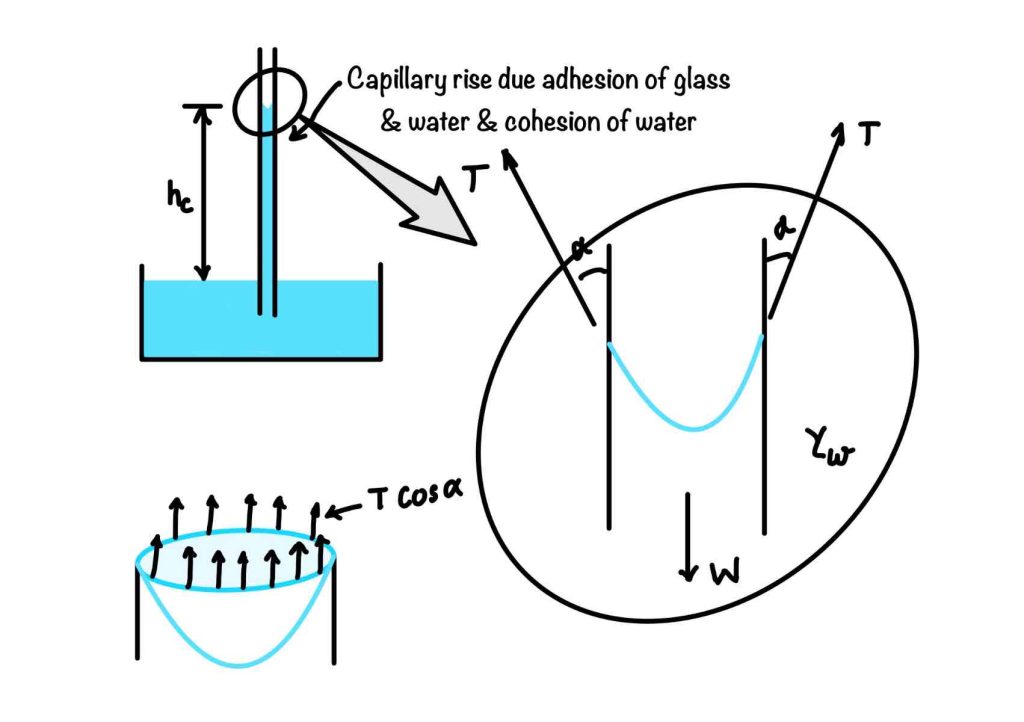You may have tried to walk in the sand, but it is challenging. But the same sand near sea shore is hard enough to run even a truck. In general we can say capillary action in the soil is mainly responsible for this. This post will discuss the phenomenon that makes sea sand so strong. However, before discussing this phenomenon, let us discuss some basic things we know from school physics.
Capillary action
Capillary action is the result of adhesion and cohesion forces. For example, when we insert a narrow glass tube in the water, the adhesion force pulls it up between the water and the glass. This adhesion force is supported by the water’s cohesion force, which gives rise to surface tension. The surface tension lifts the water against the weight of the water, and the height at which the equilibrium occurs is known as capillary height.

$$ \frac{\pi d^2}{4}\times h_c \times\gamma_w = T\cos({\alpha}) \times\pi d \\ h_c = \frac{4T\cos{(\alpha)}}{d \gamma_w} $$
For clear water and glass $\alpha=0$, hence the equation becomes
$$ h_c=\frac{4T}{d\gamma_w} $$
Capillary action in the soil
Every type of soil does not support the capillary rise of water. However, the only soil with very fine pores promotes the capillary rise of water. Although like glass tubes, soil pores are not straight, and their diameter needs to be fixed, it’s not easy to calculate the capillary height of water in the soil.
💡 Capillary action increases the shear strength of soil by changing the effective stress in the soil.
How capillarity changes soil properties?
Capillarity in the soil is due to adhesion force. This force is attractive in nature, or you can imagine that it pulls two particles to climb. Due to this pull, the shear strength of the soil increased. This increased soil shear strength makes you walk on the seashore or near the river.
Capillary action in the sand makes the honeycomb structure of the particle in the sand, as shown in the figure. This honeycomb structure increases the volume of sand; this phenomenon is known as Bulking of sand. When more water is added, the thin water is washed away, and again sand volume decreases. Hence it is not suggested to buy moist sand, as you will lose in the volume of sand.
One significant loss of capillarity is the siphoning action. Due to this action of the soil, the loss of water in the canal or any water body can occur even though the crest height is enough higher than the top level of water.
Conclusions
After reading this post, you clearly know how to walk quickly in the sand near the river or sea. Capillary action of the soil increases the shear strength, which makes the soil stable.
In this post, you have learned the following points.
- Capillarity: Capillary action in the soil is measured by the effective diameter $D_{10}$.
- Pore pressure: Pore pressure in the soil due to capillary water is negative in nature. Hence this pore pressure increases the effective stress.
- Bulking of sand: Bulking occurs in the sand due to the adhesion force of the thin water layer around the particle. It increases the volume of sand.

Android Apps
⭐️ ⭐️ ⭐️ ⭐️ ⭐️ 1000+ | 400,000 + Downloads (Cumulative)
At eigenplus, our goal is to teach civil engineering students about structural analysis and design starting from the fundamental principles. We do this with the help of interactive android applications and accompanying web articles and videos.
Our apps have helped more than 400 thousand students across the world to understand and learn the concepts of structural engineering. Check out our apps on the google play store.